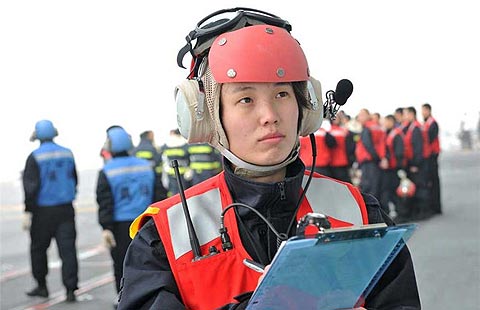Aviation experts air their opinions
Updated: 2014-03-09 23:08
By He Na, Zhao Xu, Zhao Shengnan (chinadaily.com.cn)
|
||||||||
When Malaysia Airlines flight MH370 vanished in the early hours of Saturday, it was instantly on its way to becoming one of the great riddles in modern aviation.
Some 48 hours later, experts and observers are still scratching their heads over the possible outcome of the lost airliner and the 239 people on board. As of Sunday night, 11 countries, including China, Vietnam, the US, Singapore, and the Philippines were conducting intense search operations, and still no answers.
Si Xianmin, president of China Southern Airlines, said there had never been the case before that it took so long to even locate the whereabouts of such a large and well-monitored aircraft.
With the mysterious disappearance a hot topic around the world, a range of specialists provided their insight into what might have happened.
 Zhao Yifei, professor, Air Traffic Management Institute at Civil Aviation University of China.
Zhao Yifei, professor, Air Traffic Management Institute at Civil Aviation University of China.
Hot topic: "The missing Malaysia Airlines plane has become the hottest topic among his colleagues and friends in the aviation industries."
Strong belief: "From my knowledge and experience, I think there's one thing can be sure: that whatever happened was quick and left the pilots no time to place a distress call."
Extreme weather: "I think the possibility that mechanical failure [affected the flight] when it entered into the extreme weather layer is high. The signal of the aircraft disappeared suddenly, which indicates that, except for a terrorist attack, it would have been something the plane was hard hit by thunderstorm or some other strong blows, like hail."
Depth of possible wreckage: "I think the possibility that the aircraft has already deepened in the waters is also quite high. Rescue staff may find some floating debris and seats, but for the big aircraft relics, it may take them longer or even long enough time to find.
 Mei Dongmu, aircraft designer, Aviation Industry Corporation of China
Mei Dongmu, aircraft designer, Aviation Industry Corporation of China
Weather unlikely: "It's quite common for a plane to be caught in air turbulence, something that's essentially unpredictable. And in the overwhelming majority of cases, the pilot, after sensing the instability in the plane's movement, would simply get out of trouble's way by giving the plane uplift or making a bypass around the center of the turbulences.
"But of course there are rare occasions when due to multiple reasons – the pilot has fallen into sleep being one – the threat of the bad weather was noticed only too late and the plane, out of control, plunged headlong towards the ground, or the ocean, as is widely speculated in the current case."
Search speculation: "If the plane has indeed plunged into the ocean, then it's almost impossible for us not to have found it. It's a common misperception that a crashed plane is bound to sink into the bottom of the sea – in reality, the cylindrical body of a plane would almost certainly be floating on the sea surface for some time, even if it's been broken into two or three parts.
"And all that stuff – the chairs, cushions, and plastic bags for example – will eventually form a little island of wreckage being carried away by the waves. None of that we have found so far."
Explosion theory: "So in my view, the plane hasn't dropped into the ocean or onto the ground. It has simply exploded mid-air, the metal shell breaking into million pieces that could no longer be identified.
"The bodies of the victims have probably fallen into the ocean, and it might take days for them to resurface.
"I know it's the bleakest picture possible and something that every body would be very reluctant to believe, but it's my honest judgment."
 Captain John M. Cox, pilot for US Airways for 25 years and now CEO of Safety Operating Systems.
Captain John M. Cox, pilot for US Airways for 25 years and now CEO of Safety Operating Systems.
Quick occurrence: "Whatever happened to the Malaysia Airlines jet, it occurred quickly. The problem had to be big enough to stop the plane's transponder from broadcasting its location, although the transponder can be purposely shut off from the cockpit."
Debris field: "One of the first indicators of what happened will be the size of the debris field. If it is large and spread out over tens of miles, then the plane likely broke apart at a high elevation. That could signal a bomb or a massive airframe failure.
"If it is a smaller field, the plane probably fell from 35,000 feet intact, breaking up upon contact with the water.
In sum: "We know the airplane is down. Beyond that, we don't know a whole lot."
 Ma Weiming, scholar and expert, Chinese Academy of Engineering.
Ma Weiming, scholar and expert, Chinese Academy of Engineering.
Survivors' chances: "The temperature is relatively high on the surface of the South China Sea, if there were survivors after the crash, they might hold on for some time.
"The maritime search and rescue work is completely different from that after an earthquake, which usually has 72 hours of golden saving time."
 Yan Kai, a senior engineer of China's manned deep-sea submersible research vessel "Jiaolong"
Yan Kai, a senior engineer of China's manned deep-sea submersible research vessel "Jiaolong"
Hindered rescue: "Poor infrastructure in the Nansha islands of the South China Sea has deterred China from carrying out efficient rescue.
"The suspected accident site is close to our Nansha islands, but neither a port nor an airport is available there. Actually, in the whole of Sansha city that governs the Xisha, Zhongsha and Nansha islands and their surrounding waters, there is only one small airport and one port."
 Liang Shijie, chief pilot for Civil Aviation Administration of China's central and southern regions
Liang Shijie, chief pilot for Civil Aviation Administration of China's central and southern regions
Difficult to grasp: "Almost all the communication equipment on the airplane went out of action in the missing flight of Malaysia Airlines and it is beyond understanding even for experienced pilot."
Air protocols: "Usually, once airplane gets issues, the captain will announce emergency by calling Mayday on the radio or sending code by transponder, such as 7700 for mechanical breakdown and 7500 for hijacking.
"Even if the captain cannot send out signal, the Emergency Locator Transmitter on the airplane can still send locating signals automatically when the airplane gets in an accident, and the signal can help rescuers find the site.
However, all the communication equipments did not take effect on the missing airplane. It is difficult to explain.
What's next? "The reason [for the disappearance] will be shown only after the aircraft is found. The only effective way [to find it] may be the [ongoing] surface search by the multi-national force."

 Fashions of the first ladies
Fashions of the first ladies
 Pro-Russian forces take over Ukraine's naval HQ
Pro-Russian forces take over Ukraine's naval HQ
 New US envoy hits ground running
New US envoy hits ground running
 HK cellist to perform at Carnegie Hall
HK cellist to perform at Carnegie Hall
 Skyscrapers in E China resemble LV check pattern
Skyscrapers in E China resemble LV check pattern
 President Xi honors memory of devoted county Party chief
President Xi honors memory of devoted county Party chief
 More than just food
More than just food
 Miss world visits cancer children in Colombia
Miss world visits cancer children in Colombia
Most Viewed
Editor's Picks

|

|

|

|

|

|
Today's Top News
Tour adds 'new dimension' to Sino-US ties
Hunger strike off, anger remains
China largest holder of US debt
California shelves proposal
Chinese treasures on the block
China must expand inbound tourism
Tourists offered compensation for bad air days
US first lady's China visit to boost relations
US Weekly

|

|






